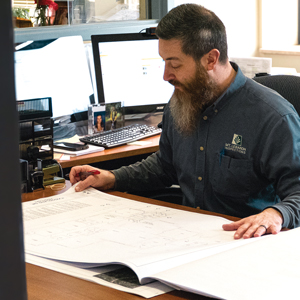share and share alike
Mt. Lebanon is a walking community of 33,000 people, in a town that sees upwards of 60,000 vehicles a day passing through. So everyone—drivers, pedestrians and cyclists—has to coexist. And that’s not always easy.
![]() In keeping with the Commission’s goal of increasing traffic and pedestrian safety, Mt. Lebanon has launched a campaign called Look Up Lebo. The campaign is based on three fundamental components of traffic safety: engineering (enhancing the physical safety of the streets), education (reminding people of safe practices) and enforcement (making sure people follow the rules).
In keeping with the Commission’s goal of increasing traffic and pedestrian safety, Mt. Lebanon has launched a campaign called Look Up Lebo. The campaign is based on three fundamental components of traffic safety: engineering (enhancing the physical safety of the streets), education (reminding people of safe practices) and enforcement (making sure people follow the rules).
Because of the sheer volume of both vehicles and pedestrians, the Washington and Beverly business districts are the two spots that account for most of the driver/walker/cyclist friction, says Officer Mike Shell of the police department’s traffic unit.
The high school is also a trouble spot when school is in session, because many parents disregard the school district’s request to drop children off in the rear of the building instead of clogging traffic on Cochran Road, Shell says. And another problem area, is the crosswalk in front of busy Washington School.
The Washington crosswalk is equipped with flashing amber lights embedded in the street and on poles that are activated by a push button. Many pedestrians mistakenly think that pressing the button that activates the lights automatically stops traffic when in fact, the lights simply let drivers know someone wishes to cross the street.

While pedestrians—once they enter a crosswalk—usually have the right of way, Shell says the Pennsylvania Vehicle Code also requires pedestrians to ensure conditions are safe before attempting to cross a street. “So many times, we’ll see someone push the button and just walk right into the intersection without even checking the traffic first,” says Shell. “They’re just warning lights. They’re not a force field.” Don’t assume the cars will stop. Stay on the curb until the vehicles in the roadway yield and you can cross safely.
With school back in session, the school district’s Go Zones—areas where parents can quickly drop off and pick up their children—will be in effect. The Go Zone rules are posted outside each school. Signs spell out parking and traffic-related rules. Please do not park in restricted areas and, if your children must cross a street, make sure they use a crosswalk with a crossing guard. To see a map of all of the elementary school Go Zones, visit .
The police department already has a number of programs in place to promote safe navigation of the streets: Safe walking programs in the schools, new driver education in the high school, Impaired Driver (DUI) checkpoints and programs to stress seat belt safety and to deter aggressive driving, and a Road Sense brochure that offers tips for safe walking, biking and driving and also how to be safe in construction zones.

Mt. Lebanon partnered with Allstate Insurance to purchase two speed alert trailers, which, more than simply flashing a driver’s speed, can be used to gather traffic data. In a typical week in the 1400 block of Washington Road, the trailer recorded 70,661 vehicles driving through, with an average speed of 38 miles per hour (in a 35 mph zone), and a maximum speed of 73 miles per hour. Most important, 75 percent of the drivers who were exceeding the speed limit slowed down after the sign posted their speeds.
Driving 38 in a 35 zone will not result in a ticket. Nor will driving 40, or even 45. Speed devices other than radar must give a 10-mph cushion to drivers before issuing a speeding ticket. And in Pennsylvania, the only law enforcement agency allowed to use radar is the state police. So you can get nailed going 70 in a 65 zone on the turnpike, but that 35 mph sign on Washington actually means 35 to 45.
“A lot of times we get speeding complaints from people in residential areas, and if we do a traffic study and find the average speed is less than 10 miles over, we can’t write tickets for that,” Shell says.
In 2014, Mt. Lebanon made 5,393 traffic stops, which resulted in 4,314 citations. The department also made 118 DUI arrests. There were 624 crashes in Mt. Lebanon in 2015. Of those, 10 involved pedestrians and 73 involved deer.

In the spring, Mt. Lebanon passed an ordinance allowing officers to cite pedestrians who cross against the pedestrian control signals. This was greeted with a fair amount of controversy, with residents complaining at commission meetings about feeling targeted and singled out by the police department, which in many of the speakers’ opinions, did nothing to stop drivers, who they believed to be the real problem.
Since the ordinance passed in May, traffic officer Cory Nolte says he has written only one citation, but has issued several warnings.
“We’re not trying to ring up fines and citations,” he says. “We’re more about modifying behaviors through education than about enforcement.”
He adds that the ordinance applies only to the business districts and intersections that are controlled by pedestrian control signals. “On a residential street, you can cross anyplace at all, as long as you’re safe.”
In order to see things from the pedestrians’ point of view, officers work the “Frogger” detail, based on the 1980s video game where the goal is to get a frog safely across several lanes of busy traffic.
“People definitely can see the lights, they’ll see it and put on their brakes, and give us a buffer,” says Shell. “But there are still a lot of distracted drivers out there.”
Although there is a state law against texting and driving, Nolte says the law is hard to enforce, because it is limited only to texting or surfing the web. Drivers can still talk on their phones and can also use them as GPS devices.
Of course, there are distracted pedestrians as well—people who are late for an appointment, talking or texting on their phones, wearing headsets, gabbing with their friends, trying to manage their dogs or playing Pokémon Go. And cyclists who, if not distracted themselves, become distractions when they ignore the fact that the rules of the road apply to them and their vehicles, as well as to cars.
Keeping Mt. Lebanon roads safe is complicated, but if we all Look Up Lebo, we can do better.
Safety tips for all of us
- Walk facing oncoming traffic, if a street has no sidewalk. If a street has a sidewalk, you are required to use it, even if it’s on the other side of the street from you. Follow all traffic signs, signals and markings, even if it means you have to wait your turn. Pay attention to others around you, and not your phone.
- Try to make eye contact with drivers, so you know they know you’re there.
- Don’t cross where the driver’s sight may be restricted, such as behind a parked car or an overgrown hedge. Make sure both sides of the road are clear, and there is no one passing parked or standing cars in the opposite lane.
- Follow the same traffic laws as drivers when you’re riding a bike. No cruising through stop signs or red lights. Yield the right of way to pedestrians, and give them some warning prior to overtaking and passing them. Bikes must have lights from dusk to dawn. And remember, cyclists can be arrested for DUI.
- Ride your bike on the street in the business districts. It’s against the law to ride on the sidewalks there.
Share the lane when you are cycling more slowly than motor vehicle traffic. Move as far right as you safely can. Always ride in the same direction as traffic. - Drivers should steer clear of bikes and give them at least four feet of clearance.
- Be alert to the door zone, the three to four feet of space next to parked vehicles where someone can open a door into your path. Also, be extra careful at intersections, as some drivers may not always signal when they are making a turn.
- Ride or drive at or below the posted speed limit. This gives you time to react to other vehicles, pedestrians, deer or other sudden movers.
- Keep your eyes on the road and your thumbs on the wheel.
- Move to the curb lane and stop when an emergency vehicle approaches. Slow down when you pass an emergency vehicle that is stopped on the side of the road.
- Get enough sleep. A tired driver is a distracted driver.
- Set your GPS and turn up the volume before you hit the road.
- And remember the old adage, Stop, Look and Listen before you cross the street!





